2015 Peugeot 208 light
[x] Cancel search: lightPage 76 of 341
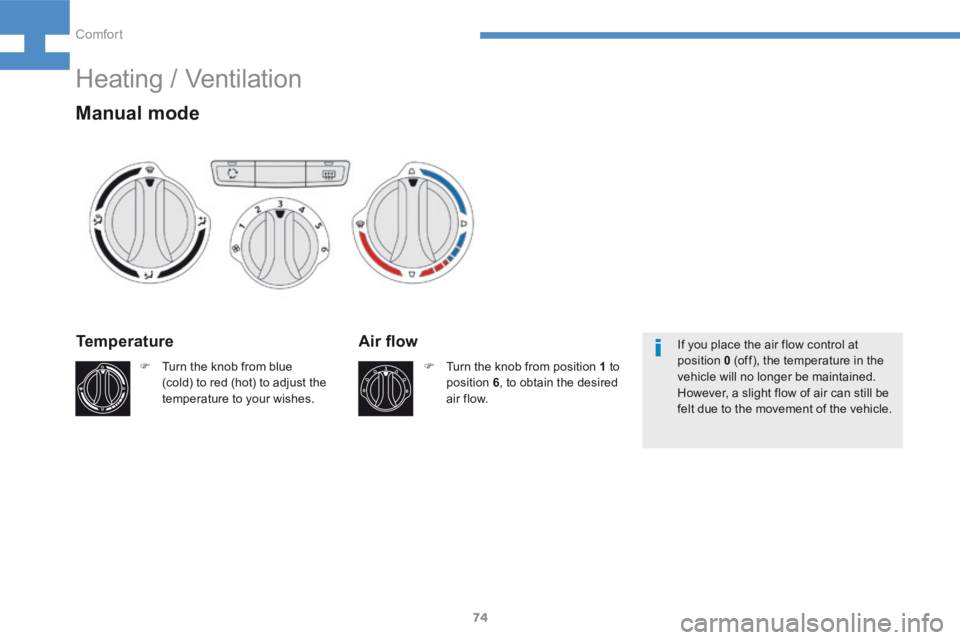
74
208_en_Chap04_confort_ed01-2015
Temperature
F Turn the knob from blue
(cold) to red (hot) to adjust the
temperature to your wishes.
Air flow
F Turn the knob from position 1 to
position 6 , to obtain the desired
air f low. If you place the air flow control at
position 0 (off), the temperature in the
vehicle will no longer be maintained.
However, a slight flow of air can still be
felt due to the movement of the vehicle.
Heating / Ventilation
Manual mode
Comfort
Page 78 of 341
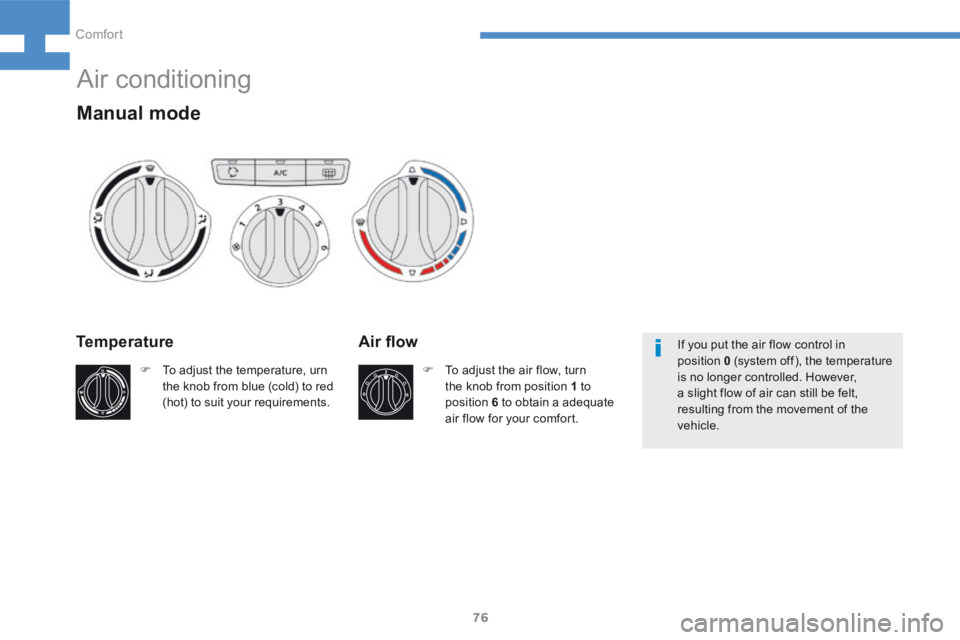
76
208_en_Chap04_confort_ed01-2015
Temperature
F To adjust the temperature, urn
the knob from blue (cold) to red
(hot) to suit your requirements.
Air flow
F To adjust the air flow, turn
the knob from position 1 to
position 6 to obtain a adequate
air flow for your comfort. If you put the air flow control in
position
0 (system off), the temperature
is no longer controlled. However,
a slight flow of air can still be felt,
resulting from the movement of the
vehicle.
Air conditioning
Manual mode
Comfort
Page 82 of 341
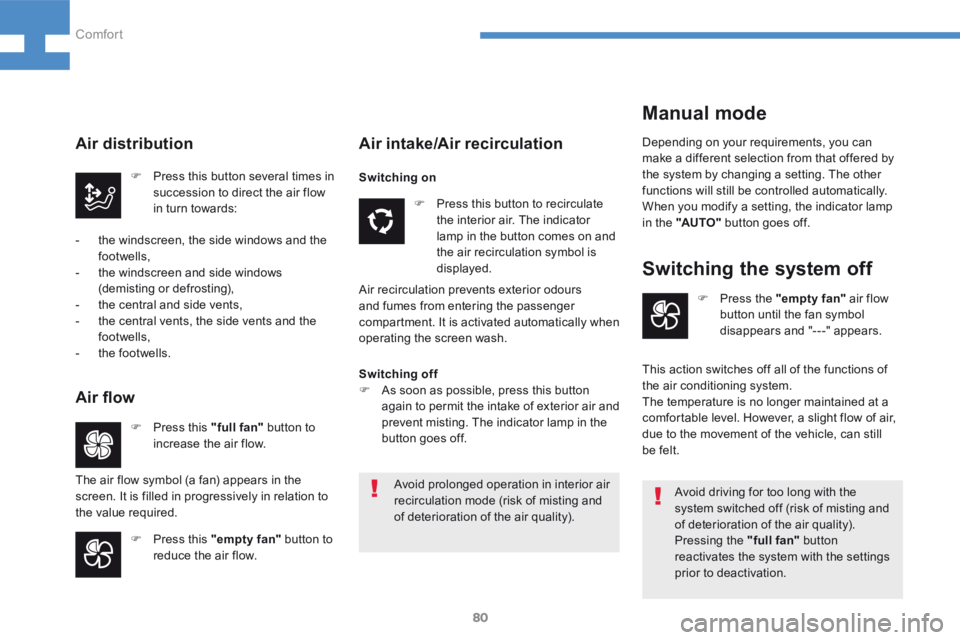
80
208_en_Chap04_confort_ed01-2015
Avoid prolonged operation in interior air
recirculation mode (risk of misting and
of deterioration of the air quality).
Switching the system off
Air intake/Air recirculation
F Press this "full fan" button to
increase the air flow.
Air distribution
F Press the "empty fan" air flow
button until the fan symbol
disappears and "---" appears.
This action switches off all of the functions of
the air conditioning system.
The temperature is no longer maintained at a
comfortable level. However, a slight flow of air,
due to the movement of the vehicle, can still
be felt.
F
Press this button to recirculate
the interior air. The indicator
lamp in the button comes on and
the air recirculation symbol is
displayed.
Air recirculation prevents exterior odours
and fumes from entering the passenger
compartment. It is activated automatically when
operating the screen wash.
F
Press this button several times in
succession to direct the air flow
in turn towards:
- the windscreen, the side windows and the
footwells,
- the windscreen and side windows
(demisting or defrosting),
- the central and side vents,
- the central vents, the side vents and the
footwells,
- the footwells.
Air flow
The air flow symbol (a fan) appears in the
screen. It is filled in progressively in relation to
the value required.
F Press this "empty fan" button to
reduce the air flow. Avoid driving for too long with the
system switched off (risk of misting and
of deterioration of the air quality).
Pressing the "full fan"
button
reactivates the system with the settings
prior to deactivation.
Switching on
Switching off
F
As soon as possible, press this button
again to permit the intake of exterior air and
prevent misting. The indicator lamp in the
button goes off.
Manual mode
Depending on your requirements, you can
make a different selection from that offered by
the system by changing a setting. The other
functions will still be controlled automatically.
When you modify a setting, the indicator lamp
in the "AUTO" button goes off.
Comfort
Page 106 of 341
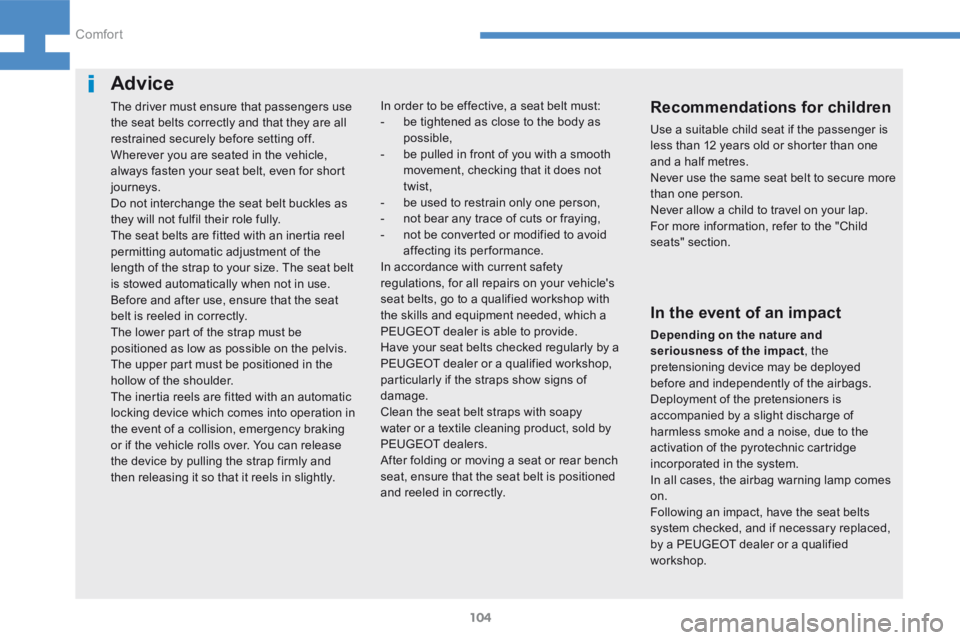
104
208_en_Chap04_confort_ed01-2015
Advice
The driver must ensure that passengers use
the seat belts correctly and that they are all
restrained securely before setting off.
Wherever you are seated in the vehicle,
always fasten your seat belt, even for short
journeys.
Do not interchange the seat belt buckles as
they will not fulfil their role fully.
The seat belts are fitted with an inertia reel
permitting automatic adjustment of the
length of the strap to your size. The seat belt
is stowed automatically when not in use.
Before and after use, ensure that the seat
belt is reeled in correctly.
The lower part of the strap must be
positioned as low as possible on the pelvis.
The upper part must be positioned in the
hollow of the shoulder.
The inertia reels are fitted with an automatic
locking device which comes into operation in
the event of a collision, emergency braking
or if the vehicle rolls over. You can release
the device by pulling the strap firmly and
then releasing it so that it reels in slightly.Recommendations for children
Use a suitable child seat if the passenger is
less than 12 years old or shorter than one
and a half metres.
Never use the same seat belt to secure more
than one person.
Never allow a child to travel on your lap.
For more information, refer to the "Child
seats" section.
In order to be effective, a seat belt must:
-
be tightened as close to the body as
possible,
- be pulled in front of you with a smooth
movement, checking that it does not
twist,
- be used to restrain only one person,
- not bear any trace of cuts or fraying,
- not be converted or modified to avoid
affecting its performance.
In accordance with current safety
regulations, for all repairs on your vehicle's
seat belts, go to a qualified workshop with
the skills and equipment needed, which a
PEUGEOT dealer is able to provide.
Have your seat belts checked regularly by a
PEUGEOT dealer or a qualified workshop,
particularly if the straps show signs of
damage.
Clean the seat belt straps with soapy
water or a textile cleaning product, sold by
PEUGEOT dealers.
After folding or moving a seat or rear bench
seat, ensure that the seat belt is positioned
and reeled in correctly.
In the event of an impact
Depending on the nature and
seriousness of the impact , the
pretensioning device may be deployed
before and independently of the airbags.
Deployment of the pretensioners is
accompanied by a slight discharge of
harmless smoke and a noise, due to the
activation of the pyrotechnic cartridge
incorporated in the system.
In all cases, the airbag warning lamp comes
on.
Following an impact, have the seat belts
system checked, and if necessary replaced,
by a PEUGEOT dealer or a qualified
workshop.
Comfort
Page 107 of 341
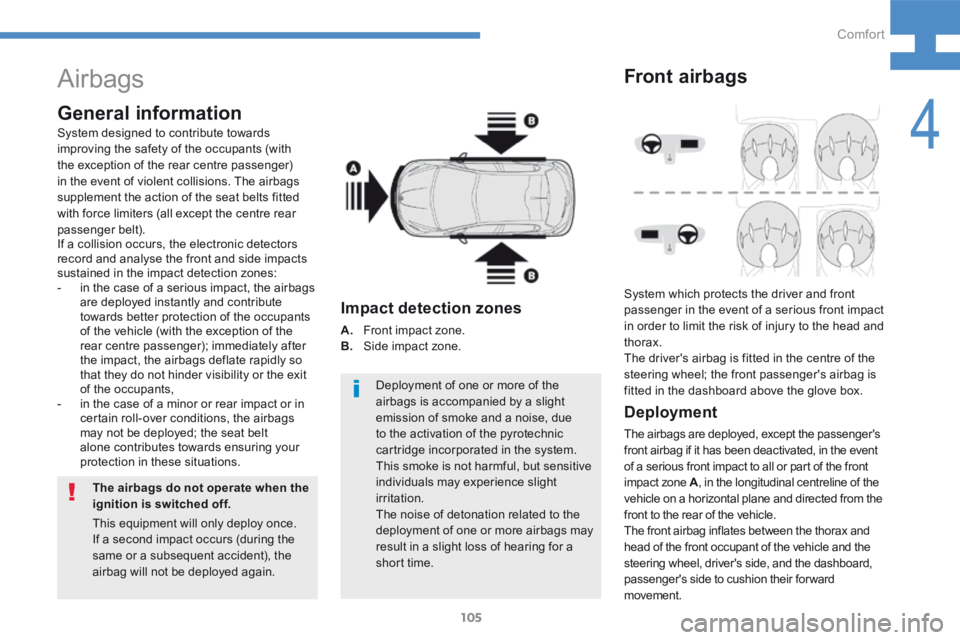
105
208_en_Chap04_confort_ed01-2015
Airbags
General information
The airbags do not operate when the
ignition is switched off.Deployment of one or more of the
airbags is accompanied by a slight
emission of smoke and a noise, due
to the activation of the pyrotechnic
cartridge incorporated in the system.
This smoke is not harmful, but sensitive
individuals may experience slight
irritation.
The noise of detonation related to the
deployment of one or more airbags may
result in a slight loss of hearing for a
short time.
Impact detection zones
A.
Front impact zone.
B. Side impact zone.
Front airbags
Deployment
The airbags are deployed, except the passenger's
front airbag if it has been deactivated, in the event
of a serious front impact to all or part of the front
impact zone A, in the longitudinal centreline of the
vehicle on a horizontal plane and directed from the
front to the rear of the vehicle.
The front airbag inflates between the thorax and
head of the front occupant of the vehicle and the
steering wheel, driver's side, and the dashboard,
passenger's side to cushion their forward
movement. System which protects the driver and front
passenger in the event of a serious front impact
in order to limit the risk of injury to the head and
thorax.
The driver's airbag is fitted in the centre of the
steering wheel; the front passenger's airbag is
fitted in the dashboard above the glove box.
This equipment will only deploy once.
If a second impact occurs (during the
same or a subsequent accident), the
airbag will not be deployed again.
System designed to contribute towards
improving the safety of the occupants (with
the exception of the rear centre passenger)
in the event of violent collisions. The airbags
supplement the action of the seat belts fitted
with force limiters (all except the centre rear
passenger belt).
If a collision occurs, the electronic detectors
record and analyse the front and side impacts
sustained in the impact detection zones:
-
in the case of a serious impact, the airbags
are deployed instantly and contribute
towards better protection of the occupants
of the vehicle (with the exception of the
rear centre passenger); immediately after
the impact, the airbags deflate rapidly so
that they do not hinder visibility or the exit
of the occupants,
- in the case of a minor or rear impact or in
certain roll-over conditions, the airbags
may not be deployed; the seat belt
alone contributes towards ensuring your
protection in these situations.
4
Comfort
Page 111 of 341
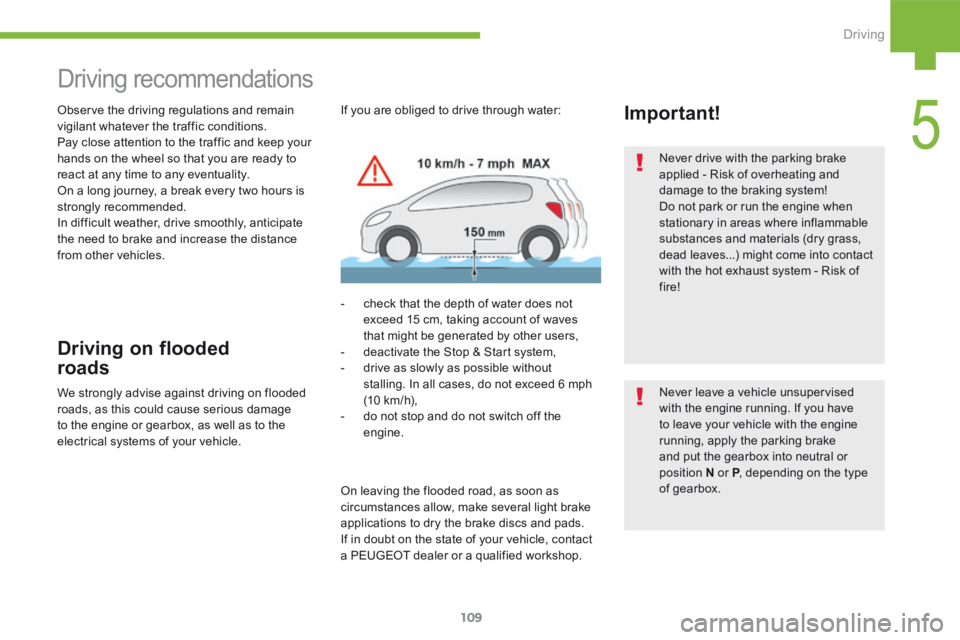
109
208_en_Chap05_conduite_ed01-2015
Never drive with the parking brake
applied - Risk of overheating and
damage to the braking system!
Do not park or run the engine when
stationary in areas where inflammable
substances and materials (dry grass,
dead leaves...) might come into contact
with the hot exhaust system - Risk of
fire!
Never leave a vehicle unsupervised
with the engine running. If you have
to leave your vehicle with the engine
running, apply the parking brake
and put the gearbox into neutral or
position N or P, depending on the type
of gearbox.
Driving recommendations
Observe the driving regulations and remain
vigilant whatever the traffic conditions.
Pay close attention to the traffic and keep your
hands on the wheel so that you are ready to
react at any time to any eventuality.
On a long journey, a break every two hours is
strongly recommended.
In difficult weather, drive smoothly, anticipate
the need to brake and increase the distance
from other vehicles. If you are obliged to drive through water:Important!
Driving on flooded
roads
- check that the depth of water does not
exceed 15 cm, taking account of waves
that might be generated by other users,
- deactivate the Stop & Start system,
- drive as slowly as possible without
stalling. In all cases, do not exceed 6 mph
(10 km/h),
- do not stop and do not switch off the
engine.
We strongly advise against driving on flooded
roads, as this could cause serious damage
to the engine or gearbox, as well as to the
electrical systems of your vehicle.
On leaving the flooded road, as soon as
circumstances allow, make several light brake
applications to dry the brake discs and pads.
If in doubt on the state of your vehicle, contact
a PEUGEOT dealer or a qualified workshop.
5
Driving
Page 113 of 341
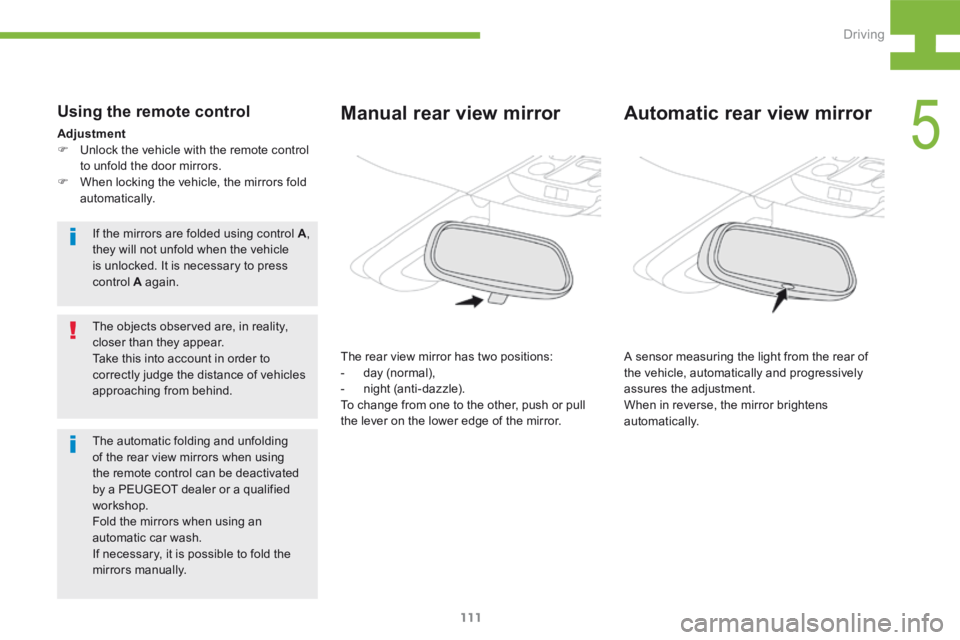
111
208_en_Chap05_conduite_ed01-2015
Automatic rear view mirror
A sensor measuring the light from the rear of
the vehicle, automatically and progressively
assures the adjustment.
When in reverse, the mirror brightens
automatically.
Manual rear view mirrorUsing the remote control
Adjustment
F Unlock the vehicle with the remote control
to unfold the door mirrors.
F When locking the vehicle, the mirrors fold
automatically.
The objects observed are, in reality,
closer than they appear.
Take this into account in order to
correctly judge the distance of vehicles
approaching from behind. If the mirrors are folded using control A ,
they will not unfold when the vehicle
is unlocked. It is necessary to press
control A again.
The automatic folding and unfolding
of the rear view mirrors when using
the remote control can be deactivated
by a PEUGEOT dealer or a qualified
workshop.
Fold the mirrors when using an
automatic car wash.
If necessary, it is possible to fold the
mirrors manually. The rear view mirror has two positions:
-
day (normal),
- night (anti-dazzle).
To change from one to the other, push or pull
the lever on the lower edge of the mirror.
5
Driving
Page 139 of 341
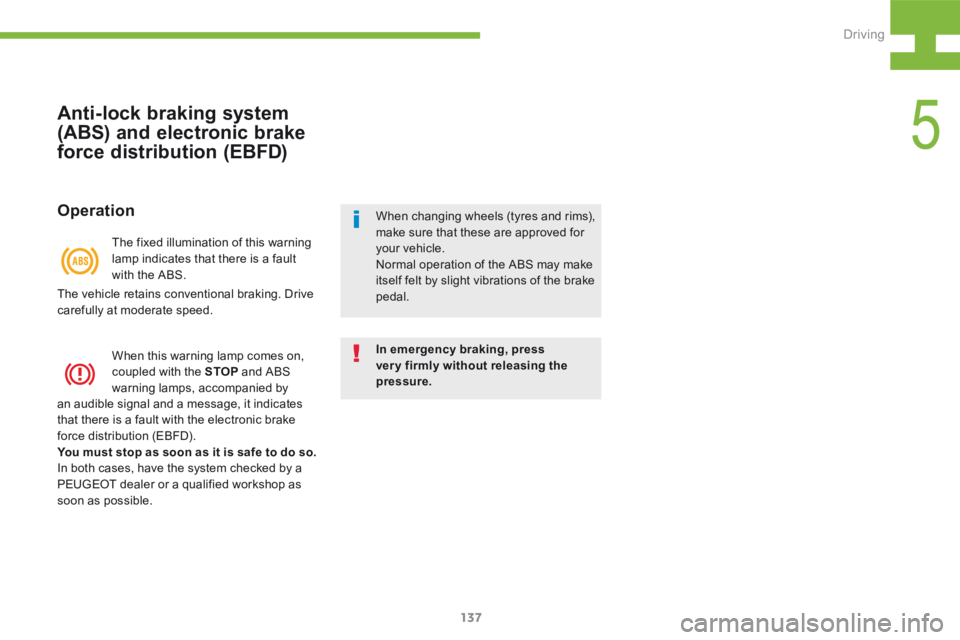
137
208_en_Chap05_conduite_ed01-2015
Anti-lock braking system
(ABS) and electronic brake
force distribution (EBFD)
Operation
In emergency braking, press
very firmly without releasing the
pressure. When changing wheels (tyres and rims),
make sure that these are approved for
your vehicle.
Normal operation of the ABS may make
itself felt by slight vibrations of the brake
pedal.
The fixed illumination of this warning
lamp indicates that there is a fault
with the ABS.
When this warning lamp comes on,
coupled with the STOP
and ABS
warning lamps, accompanied by
The vehicle retains conventional braking. Drive
carefully at moderate speed.
an audible signal and a message, it indicates
that there is a fault with the electronic brake
force distribution (EBFD).
You must stop as soon as it is safe to do so.
In both cases, have the system checked by a
PEUGEOT dealer or a qualified workshop as
soon as possible.
5
Driving